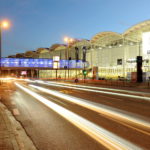In the first week of September, the Who’s Who of the maritime industry will meet in Hamburg for SMM. Under the motto of »Trends in SMMart Shipping«, the event will occupy 13 halls (see inside back cover for area plan) and focus on all the top items on the industry’s agenda
A round 50,000 international visitors are expected to attend SMM, and more than 2,200 exhibitors will be present. For the[ds_preview] first time there will also be a special exhibition on 3D-printing for the maritime industry, as well as a new theme route for the cruise and ferry segments. A comprehensive conference programme will accompany the four-day fair.
Top items on the agenda will be the digital revolution, eco-friendly propulsion technologies, new growth opportunities and the challenges associated with disruptive markets. During a high-level discussion at the forefront of SMM, Martin Stopford, the non-executive President of the maritime consultancy Clarksons Research, named digitalisation a key driver of increased efficiency within the sector. However, the expert cautioned, a stepwise approach would be advisable: »It is better to do something simple that delivers for your business, rather than getting disappointed with attempting something too ambitious that fails,« he stressed. A »Smart Shipping Toolbox« could help to build smarter ships, manage fleets smarter, and ensure logistics are really efficient, Stopford said. The goal would be an integrated transport service.
As Kjersti Kleven, Co-owner and Board Member of the Norwegian shipbuilding group Kleven Maritime AS and Chairwoman of SEA Europe, the Shipyards’ and Maritime Equipment Association, reported, shipbuilders are increasingly able to benefit from the enormous advances in the field of robotics. In the age of digitalisation, investments in research and development were of paramount importance for the industry, she said. As for 3D printing, the realisation of many ideas would still be a long way off, but the technology held a lot of promise and could give rise to new business models, Kleven added.
Referring to the fact that new regulations on CO2 emissions and ballast water management are actually likely to stimulate the business of shipbuilders and suppliers, the SEA Europe chairwoman simply stated: »We will build everything the market demands.« However, it would not always be easy for customers to identify the most suitable technology, she said. While the situation in some market segments has improved, the survival of many shipyards and suppliers depends on niche markets such as the cruise ship segment, which has seen an unprecedented boom in Europe, as Kleven pointed out. She hopes the offshore segment will recover, as well. At the same time she stressed the importance of knowledge transfer into new and attractive fields such as marine research, deep-sea mining and the utilisation of Arctic resources.
Contributing the perspective of a major supplier, Wayne Jones, Member of the Executive Board – Global Sales & Aftersales at the engine manufacturer MAN Diesel & Turbo SE, called the recent decisions made by the International Maritime Organization IMO, regarding the reduction of greenhouse gas emissions, »an enormous success«, admitting that the goal is very ambitious. It is therefore very important for the entire industry to support this decision: »We have been promoting a maritime energy transition for years, and we are committed to driving a CO2-neutral global economy that includes shipping,« Jones emphasised. »We firmly believe that the switch to low emission gas fuels is the silver bullet to decarbonize international shipping,« he added.
Radiating confidence about the future of shipping, Knut Ørbeck-Nilssen, CEO of DNV GL – Maritime, was sure that the »digital transformation will forever change the shipping industry and pave the way to new business models.« For example, he said, detailed, real-time cargo and route information as well as data relating to the operation and condition of the vessel and its components will make future supply chains much more adaptable and efficient.
»The development and spread of cloud based technologies and computer power will change not only how we manage data but how we design, build and test vessels, their systems and components,« he said. Even today digital solutions are unfolding their economic potential in concrete ways: For instance, the classification society uses drones equipped with cameras to inspect structural elements in ships, tanks or offshore installations; and since last October, customers have been able to manage ship certificates in electronic format. More than 100,000 certificates for about 8,000 ships have been issued by DNV GL to date. Apart from increasing the efficiency of operational processes, digitalisation will also improve safety on board. »The new level of decision support will give us better control over assets and systems, increase onboard situational awareness, and reduce human factor incidents and operational risk,« said Ørbeck-Nilssen. Kjersti Kleven agreed that major advances in this field lie ahead: Another innovation, the »digital twin« of a ship, provides ship owners and ship builders alike with an entirely new level of data transparency, allowing them to sell added value with their ships by optimizing operation or maintenance.
Reducing complexity, enhancing transparency: This is where MAN’s Wayne Jones sees the key benefits of digitalisation. To aggregate all the different data collected separately in a variety of storage locations, a joint platform for the entire industry is under development. Jones emphasised the importance of protecting data privacy and security, announcing a major digital innovation developed by his company to be showcased at SMM. Cybersecurity is also the subject matter of a joint project undertaken by the classification societies organised in the IACS, Ørbeck-Nilssen reported. The organisation is also developing a common terminology for different levels of autonomous ship operation. »This is a highly interesting field which is developing fast,« shipyard owner Kleven added. The first autonomous ship will be contracted very soon, she said. However, many technical and legal questions must be answered before this technology can even be considered for large container ships, interjected Hapag-Lloyd’s COO Anthony Firmin.
Bernd Aufderheide, CEO of Hamburg Messe und Congress (HMC) promised that all these forward-looking topics were going to play a key role at SMM. In particular, the conferences focusing on digitalisation, environment, security and defence as well as deep sea mining and polar research would impart crucial knowledge the industry needs to tackle present and future challenges. »We want to deliver concrete answers to the industries most pressing questions,« he said.
Both emerging and well-established companies present the entire value chain of the maritime sector in the exhibition halls of HMC. As appropriate for the age of the digital revolution and the maritime energy turnaround, this year’s SMM will put its main emphasis on digitalisation and the environment.
Cyber Security on the agenda
One important aspect of this year’s SMM is cyber security. In the hunt for enhancing transparency and boosting efficiency big data has arrived in the shipping industry. But besides opportunities, network integration also harbours risks. At MS&D, the International Conference on Maritime Security and Defence, experts will outline how maritime enterprises can protect themselves effectively against cybercriminals. Threats originating from climate change, and security policy challenges are further items on the agenda.
According to the Global Risk Report 2018, the number of cyber attacks against companies has nearly doubled over the past five years. The shipping industry has not remained unscathed. Last year, industry leader Maersk was the most prominent victim of a hacker attack, this year China’s COSCO followed just recently, suffering attacks on their IT systems in the Americas region.
The leaders of the shipping industry are well aware of this challenge. 80% of them consider cybersecurity as an »important« or »very important« issue, the current SMM Maritime Industry Report (MIR) concludes. This will be the tenth time this conference featuring top-ranking experts takes place. And again its comprehensive programme will extend over two days at SMM.
Geostrategic consequences of global warming will be another major topic at MS&D. According to recent research done by the University of Colorado at Boulder, coastal sea levels will rise by an average of 65 centimetres by the year 2100 compared to 2005, twice the increase previously predicted by most experts. A dangerous scenario, especially for ports and coastal communities. Amid refugee crises, regional tensions and international terrorism, navies and coast guards around the globe respond to new threats by updating and expanding their capacities – another topic that will be discussed at MS&D.
Green Shipping makes headway
Of course, the huge topic of »Green Shipping« won’t be ignored in Hamburg, too. Bringing effective ballast water management and a lower sulphur limit for ship fuels, new, stricter environmental regulations are forcing the shipping industry to take action.
The countdown is on: The International Maritime Organisation’s new 0.5% limit for sulphur content of ship fuels will take effect on 1 January 2020. »There is no turning back. The lower sulphur limit will have a significant positive impact on the environment and on human health, especially for people living in port cities and coastal regions,« said IMO Secretary-General Kitack Lim on occasion of the meeting of the IMO’s Sub-committee on Pollution Prevention and Response in early February.
LNG is one possible way to comply with this regulation: According to the SMM Maritime Industry Report, as many as 44% of shipowners are considering liquefied natural gas propulsion for their newbuilds.
Around the world shipowners are facing the challenge of having to make far-reaching decisions: Will low-sulphur fuel be available in sufficient quantities at reasonable prices? Are exhaust gas scrubbers a smart investment? Or would it be better to opt for LNG right away? In exhibition hall A5, which will be dedicated to the Green Propulsion theme with a special focus on LNG, decision-makers will be able to meet up with experts to get advice and study technical solutions hands-on.
As for ballast water management (BWM), the IMO is granting shipowners a transitional period before they must fully comply. Meanwhile, the industry is working full speed on implementing the BWM Convention which took effect in 2017. This necessitates investments in the order of billions. In a study of the global ballast water management market between now and the year 2026, the U.S. market research firm Stratistics MRC forecasts a growth rate of nearly 40% – per year. Understanding which types of BWM system are suitable for a specific ship type, and which of these systems meet both the IMO rules and the stricter requirements of the U.S. Coast Guard is challenging. »Numerous manufacturers are reporting record numbers of incoming orders,« says Claus Ulrich Selbach, Business Unit Director – Maritime and Technology Fairs & Exhibitions at Hamburg Messe und Congress (HMC).
This year’s fair will again feature various theme-based routes to help visitors find the exhibition highlights they are looking for. »We have added a Cruise & Ferry Route to our programme,« says Selbach. »From the engine room to the bridge through to passenger cabins, this route spreads out the entire value chain before our visitors.«
Cruise industry as pioneer
When it comes to eco-friendly ship operation, the cruise industry is one step ahead of most other shipping segments, not only in response to increased environmental awareness among passengers but also because the many highly sensitive waters visited by these ships must be protected. It is the segment’s explicit goal to minimise the effects of every trip on the marine environment and on coastal regions. Here again, LNG ship fuel plays a key role. For example, AIDA Cruises ordered their third LNG-ready cruise vessel from Meyer Werft just a few weeks ago. The Japanese NGO Peace Boat’s Ecoship concept likewise favours LNG power. Apart from its dual-fuel engine, the vessel will feature ten retractable, rigid sails doubling as photovoltaic panels as well as wind turbines, and an additional 6,000m2 of on-deck solar panels. Further information on what may will be the »greenest« cruise ship yet will be available in Hall A5. RD





















